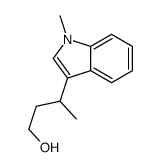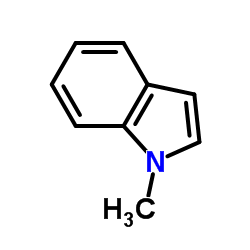(3S)-3-(1-methylindol-3-yl)butan-1-ol
Modify Date: 2024-01-02 18:24:54

(3S)-3-(1-methylindol-3-yl)butan-1-ol structure
|
Common Name | (3S)-3-(1-methylindol-3-yl)butan-1-ol | ||
|---|---|---|---|---|
| CAS Number | 406920-76-1 | Molecular Weight | 203.28000 | |
| Density | N/A | Boiling Point | N/A | |
| Molecular Formula | C13H17NO | Melting Point | N/A | |
| MSDS | Chinese | Flash Point | >212 °F | |
| Symbol |


GHS05, GHS07 |
Signal Word | Danger | |
| Name | (3S)-3-(1-methylindol-3-yl)butan-1-ol |
|---|---|
| Synonym | More Synonyms |
| Molecular Formula | C13H17NO |
|---|---|
| Molecular Weight | 203.28000 |
| Exact Mass | 203.13100 |
| PSA | 25.16000 |
| LogP | 2.66420 |
|
Section1. IDENTIFICATION OF THE SUBSTANCE/MIXTURE Product name: (3S)-(+)-3-(1-Methyl-1H-indol-3-yl)-1-butanol Section2. HAZARDS IDENTIFICATION Classification of the substance or mixture According to Regulation (EC) No1272/2008 Acute toxicity, Oral (Category 4) Skin irritation (Category 2)
Serious eye damage (Category 1) Skin sensitization (Category 1) Specific target organ toxicity - single exposure (Category 3) According to European Directive 67/548/EEC as amended. Harmful if swallowed. Irritating to respiratory system and skin. Risk of serious damage to eyes. May cause sensitization by inhalation and skin contact. Label elements Pictogram Signal wordDanger Hazard statement(s) H302Harmful if swallowed. H315Causes skin irritation. H317May cause an allergic skin reaction. H318Causes serious eye damage. H335May cause respiratory irritation. Precautionary statement(s) P261Avoid breathing dust/ fume/ gas/ mist/ vapours/ spray. P280Wear protective gloves/ eye protection/ face protection. P305 + P351 + P338IF IN EYES: Rinse cautiously with water for several minutes. Remove contact lenses, if present and easy to do. Continue rinsing. Hazard symbol(s) XnHarmful R-phrase(s) R22Harmful if swallowed. R37/38Irritating to respiratory system and skin. R41Risk of serious damage to eyes. R42/43May cause sensitization by inhalation and skin contact. S-phrase(s) S26In case of contact with eyes, rinse immediately with plenty of water and seek medical advice. S36Wear suitable protective clothing. Other hazards - none Section3. COMPOSITION/INFORMATION ON INGREDIENTS Formula: C13H17NO Molecular Weight: 203,28 g/mol CAS-No.EC-No.Index-No.ClassificationConcentration (3S)-(+)-3-(1-Methyl-1H-indol-3-yl)-1-butanol ---Acute Tox. 4; Skin Irrit. 2; Eye- Dam. 1; Skin Sens. 1; STOT SE 3; H302, H315, H317, H318, H335 Xn, R22 - R37/38 - R41 - R42/43 For the full text of the H-Statements mentioned in this Section, see Section 16. Section4. FIRST AID MEASURES General advice Consult a physician. Show this safety data sheet to the doctor in attendance. If inhaled If breathed in, move person into fresh air. If not breathing, give artificial respiration. Consult a physician. In case of skin contact Wash off with soap and plenty of water. Consult a physician. In case of eye contact Rinse thoroughly with plenty of water for at least 15 minutes and consult a physician. If swallowed Never give anything by mouth to an unconscious person. Rinse mouth with water. Consult a physician. Section5. FIRE-FIGHTING MEASURES Suitable extinguishing media Use water spray, alcohol-resistant foam, dry chemical or carbon dioxide. Special protective equipment for fire-fighters Wear self contained breathing apparatus for fire fighting if necessary. Section6. ACCIDENTAL RELEASE MEASURES Personal precautions Use personal protective equipment. Avoid breathing vapors, mist or gas. Ensure adequate ventilation. Evacuate personnel to safe areas. Environmental precautions Do not let product enter drains. Methods and materials for containment and cleaning up Soak up with inert absorbent material and dispose of as hazardous waste. Keep in suitable, closed containers for disposal. Section7. HANDLING AND STORAGE Precautions for safe handling Avoid contact with skin and eyes. Avoid inhalation of vapour or mist. Normal measures for preventive fire protection. Conditions for safe storage Keep container tightly closed in a dry and well-ventilated place. Containers which are opened must be carefully resealed and kept upright to prevent leakage. Store in cool place. Section8. EXPOSURE CONTROLS/PERSONAL PROTECTION Personal protective equipment Respiratory protection Where risk assessment shows air-purifying respirators are appropriate use a full-face respirator with multi-purpose combination (US) or type ABEK (EN 14387) respirator cartridges as a backup to engineering controls. If the respirator is the sole means of protection, use a full-face supplied air respirator. Use respirators and components tested and approved under appropriate government standards such as NIOSH (US) or CEN (EU). Hand protection Handle with gloves. Gloves must be inspected prior to use. Use proper glove removal technique (without touching glove's outer surface) to avoid skin contact with this product. Dispose of contaminated gloves after use in accordance with applicable laws and good laboratory practices. Wash and dry hands. The selected protective gloves have to satisfy the specifications of EU Directive 89/686/EEC and the standard EN 374 derived from it. Eye protection Tightly fitting safety goggles. Faceshield (8-inch minimum). Use equipment for eye protection tested and approved under appropriate government standards such as NIOSH (US) or EN 166(EU). Skin and body protection Complete suit protecting against chemicals, The type of protective equipment must be selected according to the concentration and amount of the dangerous substance at the specific workplace. Hygiene measures Handle in accordance with good industrial hygiene and safety practice. Wash hands before breaks and at the end of workday. Section9. PHYSICAL AND CHEMICAL PROPERTIES Appearance Formviscous Colourcolourless Safety data pH no data available Melting pointno data available Boiling pointno data available Flash point> 100 °C - closed cup Ignition temperature no data available Lower explosion limit no data available Upper explosion limit no data available Water solubilityno data available Section10. STABILITY AND REACTIVITY Chemical stability Stable under recommended storage conditions. Conditions to avoid no data available Materials to avoid Oxidizing agents Hazardous decomposition products Hazardous decomposition products formed under fire conditions. - Carbon oxides, nitrogen oxides (NOx) Section11. TOXICOLOGICAL INFORMATION Acute toxicity no data available Skin corrosion/irritation no data available Serious eye damage/eye irritation no data available Respiratory or skin sensitization May cause allergic skin reaction. Germ cell mutagenicity no data available Carcinogenicity IARC: No component of this product present at levels greater than or equal to 0.1% is identified as probable, possible or confirmed human carcinogen by IARC. Reproductive toxicity no data available Specific target organ toxicity - single exposure Inhalation - May cause respiratory irritation. Specific target organ toxicity - repeated exposure no data available Aspiration hazard no data available Potential health effects InhalationMay be harmful if inhaled. Causes respiratory tract irritation. IngestionHarmful if swallowed. SkinMay be harmful if absorbed through skin. Causes skin irritation. EyesCauses eye burns. Signs and Symptoms of Exposure To the best of our knowledge, the chemical, physical, and toxicological properties have not been thoroughly investigated. Additional Information RTECS: Not available Section12. ECOLOGICAL INFORMATION Toxicity no data available Persistence and degradability no data available Bioaccumulative potential no data available Mobility in soil no data available PBT and vPvB assessment no data available Other adverse effects no data available Section13. DISPOSAL CONSIDERATIONS Product Offer surplus and non-recyclable solutions to a licensed disposal company. Contact a licensed professional waste disposal service to dispose of this material. Contaminated packaging Dispose of as unused product. Section14. TRANSPORT INFORMATION ADR/RID Not dangerous goods IMDG Not dangerous goods IATA Not dangerous goods Section15. REGULATORY INFORMATION This safety datasheet complies with the requirements of Regulation (EC) No. 1907/2006. Section16. OTHER INFORMATION Text of H-code(s) and R-phrase(s) mentioned in Section 3 Acute Tox.Acute toxicity Eye Dam.Serious eye damage H302Harmful if swallowed. H315Causes skin irritation. H317May cause an allergic skin reaction. H318Causes serious eye damage. H335May cause respiratory irritation. Skin Irrit.Skin irritation Skin Sens.Skin sensitization XnHarmful R22Harmful if swallowed. R37/38Irritating to respiratory system and skin. R41Risk of serious damage to eyes. R42/43May cause sensitization by inhalation and skin contact. Further information Copyright 2010 Co. License granted to make unlimited paper copies for internal use only. The above information is believed to be correct but does not purport to be all inclusive and shall be used only as a guide. The information in this document is based on the present state of our knowledge and is applicable to the product with regard to appropriate safety precautions. It does not represent any guarantee of the properties of the product. Co., shall not be held liable for any damage resulting from handling or from contact with the above product. See reverse side of invoice or packing slip for additional terms and conditions of sale. |
| Symbol |


GHS05, GHS07 |
|---|---|
| Signal Word | Danger |
| Hazard Statements | H302-H315-H317-H318-H335 |
| Precautionary Statements | P261-P280-P305 + P351 + P338 |
| Personal Protective Equipment | Eyeshields;Faceshields;full-face respirator (US);Gloves;multi-purpose combination respirator cartridge (US);type ABEK (EN14387) respirator filter |
| RIDADR | NONH for all modes of transport |
| Flash Point(F) | >212 °F |
| Flash Point(C) | >100 °C |
|
~% 
(3S)-3-(1-methy... CAS#:406920-76-1 |
| Literature: Tian, Tian; Pei, Bao-Jian; Li, Qing-Hua; He, Hao; Chen, Ling-Yan; Zhou, Xiang; Chan, Wing-Hong; Lee, Albert W. M. Synlett, 2009 , # 13 p. 2115 - 2118 |
| Precursor 1 | |
|---|---|
| DownStream 0 | |
| (3S)-(+)-3-(1-Methyl-1H-indol-3-yl)-1-butanol |
